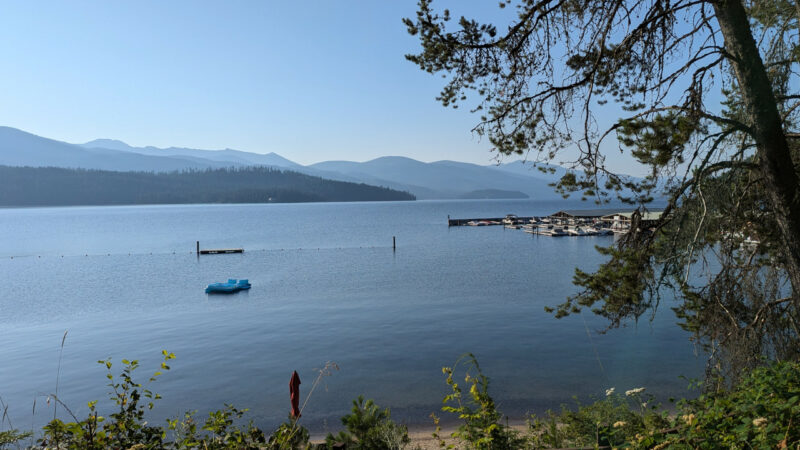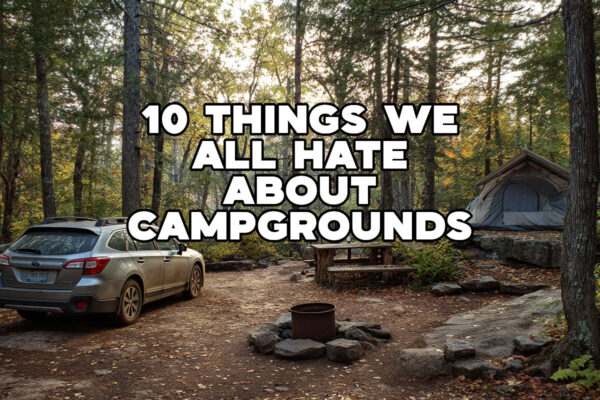Viewing wildlife at Priest Lake Idaho is not like a drive through a zoo, or a visit to Yellowstone with viewing stations to see the wildlife laid out before you. The wildlife in Idaho is wild and not served up on a platter for tourist consumption.
Priest Lake is immense and surrounded by the Kaniku National Forest and Idaho National Forest. It is home to a diverse number of creatures that are sometimes easy to find, and some that are difficult to spot under conditions that are safe and comfortable. While you are not likely to see many large creatures wandering through the woods, you will sometimes find their tracks or scat. A scat and tracks guide can be very handy in identifying just what critter has been in the area.
These are wild animals, not pets or zoo animals.
Use extreme common sense when wildlife viewing!
What Animals Can You See At Priest Lake?
The animals that you can see at Priest lake on any given day is pretty much typical for a Northwest forest. Here is a list of the main animals that people look for. Obviously there are loads of other small creatures that can be found hiding among the trees.
Elk – These giant deer with impressive antlers love spending their summers munching on grasses and leaves in high mountain meadows and forests. In the winter, they move down to lower areas with less snow, where they can find shrubs and trees to eat. If you’re lucky, you might spot a whole herd of elk grazing peacefully or hear the bugling calls of the male elk during mating season.
Deer – They’re named for the white flash of fur they show when they jump or feel scared. Unlike elk that prefer open meadows, white-tailed deer like to hang out in areas with lots of trees and bushes, like forests and places where the forest meets fields. They’re excellent hiders, so keep your eyes peeled near streams, thickets, and brush piles. In the summer, they munch on yummy leaves and plants, while in the winter, they switch to twigs and berries.
Moose – These enormous creatures are the tallest members of the deer family, with giant antlers that look like branches from a fallen tree. They love chowing down on leaves, twigs, and even water plants found in wet areas like marshes and lakes. Moose prefer hanging out in forests with plenty of trees, but you might also spot them near streams in search of food. Since they’re so big, they don’t need to hide as much as other animals. However, they are most active at dawn and dusk, so you might have a better chance of seeing them during those times.
Black Bears – North Idaho’s resident opportunists, these omnivores roam forested areas, mountainsides, and meadows, enjoying a buffet of berries, nuts, insects, and even the occasional fish or small mammal. Come fall, they’re busy bulking up on nuts for winter hibernation. While black bears are generally shy, sightings are common in North Idaho’s wilderness areas. The difficulty with seeing one is that it can rarely be done at a safe distance as most encounters are accidental.
Grizzly Bears – Once nearly wiped out due to human activity, grizzly bears are making a comeback in the far northern regions of North Idaho. Now there are an estimated 50 of them roaming the hills around the north end of Priest Lake. Solitary eaters, they enjoy a springtime root buffet, summer berries, and fall feasts to fatten up for winter hibernation. While sightings are uncommon, the best chance to spot these elusive creatures (at a safe distance) is to look for them with binoculars in the open, logged areas on the eastern side of the lake. They are most active early in the morning and late in the afternoon, avoiding the heat of day like most other creatures at the lake.
Cougars – So rare in North Idaho, that even people that live here rarely see one despite that there are estimated to be several dozen cougars roaming the hills around the lake. A female cougar can have a territory of 36 square miles, and there are only estimated to be a few dozen in all of North Idaho thanks to over-hunting and human encroachment. While they are amazing to see, you are highly unlikely to see one at a safe distance on purpose.
Lynx – Elusive predators perfectly adapted for North Idaho’s high-elevation forests. These medium-sized cats, with distinctive ear tufts and a bobbed tail, are masters of camouflage thanks to their thick, spotted fur that blends in with snowy landscapes. Their primary prey are snowshoe hares, so lynx populations tend to fluctuate with the hare population boom and bust cycles. Spotting a lynx in the wild is a rare treat, but their tracks might be found in deep snow along forested trails or near scree slopes in their mountain habitat. Wildlife cameras or guided winter tours in remote areas offer the best chance of encountering these fascinating felines.
Bobcats – North Idaho’s stealthy felines. Smaller than lynx, these reddish-brown cats with black spots prowl forests, mountains, and shrublands. Unlike lynx, they’re flexible eaters, targeting rabbits, rodents, birds, and even reptiles. Active year-round, but mostly at night. Spottings are rare, but twilight walks might reveal their markings or signs like scat or tree scratches.
Beavers – These busy rodents with webbed feet and impressive incisors call lakes, streams, and rivers home. They’re well known for their impressive dams, meticulously constructed with branches, mud, and stones. These dams not only create deep water for their lodges but also flood nearby areas, creating ideal wetland habitats for various species. Beavers are primarily herbivores, munching on bark, leaves, and aquatic plants. While mostly active at dawn and dusk, they can sometimes be spotted throughout the day swimming or hauling building materials. Keep an eye out for lodges or dams along waterways during your adventures in North Idaho.
Otters – Playful residents of North Idaho’s waterways. These sleek, semi-aquatic mammals with dense brown fur are masters of the water. They call lakes, rivers, and streams home, often seen swimming and diving in search of fish, their main prey. Otters are quite active throughout the day and their playful antics are a delight to observe. Keep an eye out for them while exploring lakes or hiking along rivers in North Idaho.
Racoons – North Idaho’s masked bandit. These clever and adaptable mammals with their characteristic black eye mask thrive in various habitats, including forests near water. Raccoons are opportunistic omnivores, enjoying a varied diet of fruits, nuts, insects, small animals, and even human scraps (be sure to properly secure your campsite!). Highly intelligent and mostly nocturnal, raccoons are more likely to be heard than seen crashing around in the night. However, you might spot their distinctive eye shine or even catch them rummaging for food at dusk or dawn.
Marmots – North Idaho’s chunky whistlepigs. These social rodents are the largest members of the squirrel family in the region. Spot them basking on rocks in high meadows and rocky areas, especially near forest edges. They live in colonies and are quite vocal, letting out loud whistles to communicate danger. Marmots hibernate in winter, so sightings are most likely in the spring, summer, and early fall.
Pika – North Idaho’s high-altitude squeak machines. These tiny, rabbit-like relatives of the marmot live in rocky areas at higher elevations. Unlike marmots, they’re solitary and prefer to stay cool in the talus (piles of rocks) created by freezing and thawing cycles. Their high-pitched calls, echoing through the mountains, are a telltale sign of their presence. Spotting a pika is a challenge, but you might see them darting between rocks on a hike in North Idaho’s alpine areas.
Bird Watching At Priest Lake
The Priest Lake area in northern Idaho is home to a diverse range of bird species due to its varied habitats, including forests, wetlands, and open water. There are approximately 200 bird species that have been recorded in the Priest Lake region. This includes both migratory and resident species, ranging from waterfowl and raptors to songbirds and woodpeckers. The area’s rich biodiversity makes it a popular spot for birdwatching, with opportunities to see a wide variety of avian life throughout the year.
Get yourself a good pair of birding binoculars and an Idaho bird guide and get out there. Hiking along rivers and streams will offer many amazing birds, and for an extra treat, get up early and kayak quieter spots to see birds other people might miss.
Bald Eagle – The Priest Lake skies are home to one of North America’s most majestic birds, the Bald Eagle. Easily identified by their massive wingspan and bright white head and tail, these birds are often seen soaring high above the treetops or perched on lookout points like snags (dead trees) scanning the lake for prey. Keep an eye out for their distinctive calls, a high-pitched chirp or piercing scream, as they communicate with each other.
Osprey – Once nearly extinct thanks to DDT, Osprey, once rare when I was a kid are now fairly common. Look for the Osprey’s brown body contrasting with a bright white chest, and listen for their distinctive screech. Unlike Bald Eagles that have a varied diet, Ospreys are specialized fish hunters. Spot them perched on snags near the water’s edge, intently focusing on the lake below. If they see a fish, they’ll dive headfirst into the water in an impressive display of agility. Listen for their high-pitched whistles or cackling calls as they communicate.
Grouse – Grouse will likely find you before you find them. The forests around Priest Lake provide excellent habitat for several grouse species, including Ruffed Grouse, Dusky Grouse, and Spruce Grouse all of which are excellent at hiding until you walk up on them and they explode into flight with a loud burst of wing beats that will stop your heart. Listen for the drumming sounds of the male Ruffed Grouse in the spring, a low, booming call that echoes through the woods. While sightings can be fleeting, encountering a grouse is a delightful reminder of the diverse birdlife inhabiting Priest Lake’s wilderness.
Loon – An unforgettable sound for any visitor to Priest Lake is the haunting cry of the loon. These large diving birds with black and white speckled bodies are most active at dawn and dusk, when their mournful calls echo across the still water. While their speckled bodies can be difficult to spot on the water itself, their calls are a guaranteed sign of their presence. If you’re lucky, you might catch a glimpse of a loon popping up to the water’s surface or swimming across a calm bay.
Wood Duck – A splash of color awaits observant visitors in the form of the Wood Duck. These vibrantly colored ducks boast a stunning plumage of iridescent greens, browns, and chestnut, with the males sporting a unique crest on their heads. They prefer the quiet coves and marshy areas around the lake where they can find plenty of food near the water’s edge. Watch for them dabbling in the shallows, their colorful bodies a beautiful contrast against the reeds and lily pads.
Great Blue Heron – Standing tall and proud along the shores of Priest Lake, you might spot the Great Blue Heron, North America’s largest wading bird. Easily recognized by its massive size, long neck, and sharp, dagger-like bill, these elegant birds are often seen stalking the shallows for prey. Their blue-grey feathers and contrasting orange legs add a touch of grandeur to the lakeside scenery. Great Blue Herons are patient hunters, remaining motionless for long periods before spearing fish, frogs, or other aquatic creatures with their lightning-fast strike. Keep an eye out for them perched on fallen logs or wading through the shallows, their watchful eyes scanning the water for their next me
Wild Turkey – Not native to the forests surrounding Priest Lake, turkeys were introduced in the 1960s to provide additional hunting options. How this has affected the native grouse population is up for debate. Most locals are not thrilled to have them here. These large ground birds are more commonly associated with open fields, but they can thrive in the diverse habitats around the lake. Listen for the gobbled calls of the males, particularly during the spring breeding season, as they strut through clearings or along forest edges to attract mates. Keep an eye out for their impressive size and distinctive black plumage with a fan-shaped tail.
The Best Way To See Wildlife At Priest Lake
Because the area around Priest Lake is heavily forested and most of the big animals are reclusive, you really have to be inventive to see much of the wildlife.
Some animals, like Whitetail Deer are pretty common and can be seen close to settled areas and around homes. Elk and bears keep their distance and are harder to spot. One way to get see these more elusive animals is to get up on the logging roads primarily on the east side of the lake, particularly early in the morning or right before dark and scan the clear cuts for animals out looking food.
The other tactic is to get out on the water in a kayak or canoe and quietly slip along the shore. This is a great way to get up close and personal with wildlife.
When To See Wildlife At Priest Lake
In my opinion, the best time to see wildlife at Priest Lake is late spring and early summer when animals are active and shaking off the winter. In the summer, most animals are active in the early morning and at sunset, avoiding the summer heat. In the fall, animals can be active again, particularly the bears as they pack on weight for the winter. During the winter, tracking animals becomes much easier, but your access is greatly reduced. Additionally, many animals, like bears, are hunkered down, waiting for spring.








